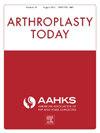Simultaneous Bilateral Total hip Arthroplasty in Patients With Juvenile Idiopathic Arthritis via Direct Anterior Approach: Long-Term Outcomes
IF 1.5
Q3 ORTHOPEDICS
引用次数: 0
Abstract
Background
Juvenile idiopathic arthritis (JIA) often results in significant bilateral hip damage, necessitating total hip arthroplasty (THA). Simultaneous bilateral THA offers potential advantages, particularly when executed via the Direct Anterior Approach (DAA). This study aims to assess the functional, radiological, and patient-reported outcomes, along with the complications of bilateral uncemented THA performed via DAA in patients with JIA.
Methods
A retrospective review of 39 patients with JIA who underwent bilateral THA via DAA from January 2006-January 2015 was conducted. Inclusion and exclusion criteria were defined, focusing on a minimum of 7 years of post-THA follow-up. Functional outcomes were assessed using the Harris Hip Score.
Results
Data were available for 33 patients (66 hips). The mean age at surgery was 21.3 years, and the average follow-up was 11.3 years. All patients reported severe bilateral hip pain presurgery, which was alleviated post-THA. The mean preoperative Harris Hip Score improved from 49.6-79.7 postoperatively. Complications included 3 calcar cracks, 2 greater trochanter fractures, and 1 superficial wound dehiscence. No instances of dislocation, postoperative periprosthetic fracture, or any revision surgery were recorded.
Conclusions
Simultaneous bilateral THA using DAA is an effective and safe surgical approach for patients with JIA with bilateral end-stage hip involvement, providing notable improvements in functional and radiological outcomes while maintaining a favorable complication profile.
Level of evidence
IV.
通过直接前路为幼年特发性关节炎患者同时进行双侧全髋关节置换术:长期疗效
背景青少年特发性关节炎(JIA)常常导致双侧髋关节严重受损,因此必须进行全髋关节置换术(THA)。同时进行双侧全髋关节置换术具有潜在的优势,尤其是通过直接前路(DAA)进行手术时。本研究旨在评估 JIA 患者通过 DAA 实施双侧非骨水泥 THA 的功能、放射学和患者报告结果以及并发症。方法回顾性研究了 2006 年 1 月至 2015 年 1 月期间通过 DAA 实施双侧 THA 的 39 例 JIA 患者。界定了纳入和排除标准,重点关注THA术后至少7年的随访。结果 33 名患者(66 个髋关节)的数据可用。手术时的平均年龄为21.3岁,平均随访时间为11.3年。所有患者术前均报告有严重的双侧髋关节疼痛,THA术后疼痛有所缓解。术前的平均哈里斯髋关节评分在术后从49.6分提高到79.7分。并发症包括3处髋臼钙裂、2处大转子骨折和1处浅表伤口裂开。结论对于双侧髋关节终末期受累的JIA患者来说,使用DAA同时进行双侧THA是一种有效而安全的手术方法,在保持良好并发症情况的同时,明显改善了患者的功能和放射学结果。
本文章由计算机程序翻译,如有差异,请以英文原文为准。
求助全文
约1分钟内获得全文
求助全文
来源期刊

Arthroplasty Today
Medicine-Surgery
CiteScore
2.90
自引率
0.00%
发文量
258
审稿时长
40 weeks
期刊介绍:
Arthroplasty Today is a companion journal to the Journal of Arthroplasty. The journal Arthroplasty Today brings together the clinical and scientific foundations for joint replacement of the hip and knee in an open-access, online format. Arthroplasty Today solicits manuscripts of the highest quality from all areas of scientific endeavor that relate to joint replacement or the treatment of its complications, including those dealing with patient outcomes, economic and policy issues, prosthetic design, biomechanics, biomaterials, and biologic response to arthroplasty. The journal focuses on case reports. It is the purpose of Arthroplasty Today to present material to practicing orthopaedic surgeons that will keep them abreast of developments in the field, prove useful in the care of patients, and aid in understanding the scientific foundation of this subspecialty area of joint replacement. The international members of the Editorial Board provide a worldwide perspective for the journal''s area of interest. Their participation ensures that each issue of Arthroplasty Today provides the reader with timely, peer-reviewed articles of the highest quality.
 求助内容:
求助内容: 应助结果提醒方式:
应助结果提醒方式:


